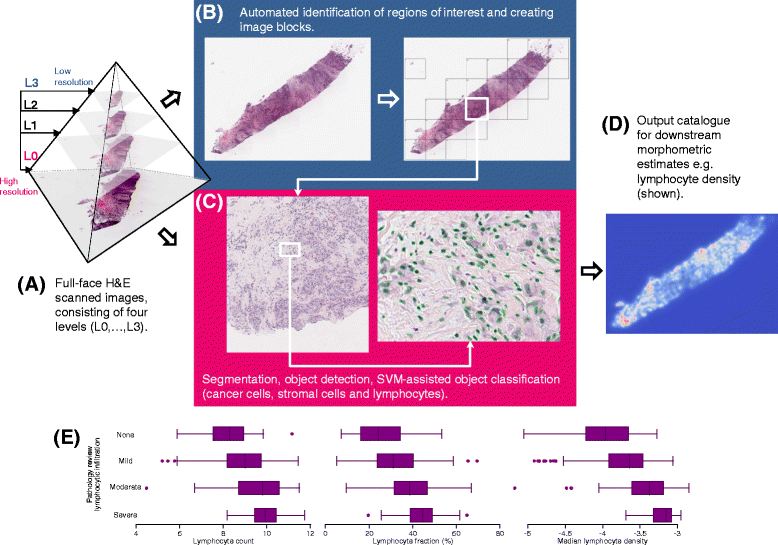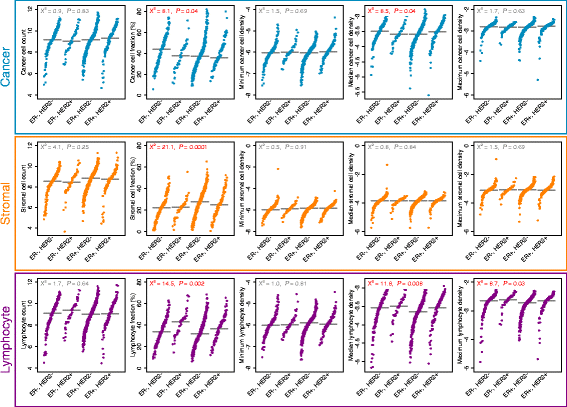Computational pathology of pre-treatment biopsies identifies lymphocyte density as a predictor of response to neoadjuvant chemotherapy in breast cancer
- PMID: 26882907
- PMCID: PMC4755003
- DOI: 10.1186/s13058-016-0682-8
Computational pathology of pre-treatment biopsies identifies lymphocyte density as a predictor of response to neoadjuvant chemotherapy in breast cancer
Abstract
Background: There is a need to improve prediction of response to chemotherapy in breast cancer in order to improve clinical management and this may be achieved by harnessing computational metrics of tissue pathology. We investigated the association between quantitative image metrics derived from computational analysis of digital pathology slides and response to chemotherapy in women with breast cancer who received neoadjuvant chemotherapy.
Methods: We digitised tissue sections of both diagnostic and surgical samples of breast tumours from 768 patients enrolled in the Neo-tAnGo randomized controlled trial. We subjected digital images to systematic analysis optimised for detection of single cells. Machine-learning methods were used to classify cells as cancer, stromal or lymphocyte and we computed estimates of absolute numbers, relative fractions and cell densities using these data. Pathological complete response (pCR), a histological indicator of chemotherapy response, was the primary endpoint. Fifteen image metrics were tested for their association with pCR using univariate and multivariate logistic regression.
Results: Median lymphocyte density proved most strongly associated with pCR on univariate analysis (OR 4.46, 95 % CI 2.34-8.50, p < 0.0001; observations = 614) and on multivariate analysis (OR 2.42, 95 % CI 1.08-5.40, p = 0.03; observations = 406) after adjustment for clinical factors. Further exploratory analyses revealed that in approximately one quarter of cases there was an increase in lymphocyte density in the tumour removed at surgery compared to diagnostic biopsies. A reduction in lymphocyte density at surgery was strongly associated with pCR (OR 0.28, 95 % CI 0.17-0.47, p < 0.0001; observations = 553).
Conclusions: A data-driven analysis of computational pathology reveals lymphocyte density as an independent predictor of pCR. Paradoxically an increase in lymphocyte density, following exposure to chemotherapy, is associated with a lack of pCR. Computational pathology can provide objective, quantitative and reproducible tissue metrics and represents a viable means of outcome prediction in breast cancer.
Trial registration: ClinicalTrials.gov NCT00070278 ; 03/10/2003.
Figures





Similar articles
-
Lymphocyte density determined by computational pathology validated as a predictor of response to neoadjuvant chemotherapy in breast cancer: secondary analysis of the ARTemis trial.Ann Oncol. 2017 Aug 1;28(8):1832-1835. doi: 10.1093/annonc/mdx266. Ann Oncol. 2017. PMID: 28525534 Free PMC article. Clinical Trial.
-
Effects of the addition of gemcitabine, and paclitaxel-first sequencing, in neoadjuvant sequential epirubicin, cyclophosphamide, and paclitaxel for women with high-risk early breast cancer (Neo-tAnGo): an open-label, 2×2 factorial randomised phase 3 trial.Lancet Oncol. 2014 Feb;15(2):201-12. doi: 10.1016/S1470-2045(13)70554-0. Epub 2013 Dec 19. Lancet Oncol. 2014. PMID: 24360787 Clinical Trial.
-
Docetaxel followed by fluorouracil/epirubicin/cyclophosphamide as neoadjuvant chemotherapy for patients with primary breast cancer.Jpn J Clin Oncol. 2011 Jul;41(7):867-75. doi: 10.1093/jjco/hyr081. Jpn J Clin Oncol. 2011. PMID: 21719750 Clinical Trial.
-
Mammographic breast density: Predictive value for pathological response to neoadjuvant chemotherapy in breast cancer patients.Breast. 2015 Oct;24(5):576-81. doi: 10.1016/j.breast.2015.05.007. Epub 2015 Jun 10. Breast. 2015. PMID: 26071795
-
Prospective validation of immunological infiltrate for prediction of response to neoadjuvant chemotherapy in HER2-negative breast cancer--a substudy of the neoadjuvant GeparQuinto trial.PLoS One. 2013 Dec 2;8(12):e79775. doi: 10.1371/journal.pone.0079775. eCollection 2013. PLoS One. 2013. PMID: 24312450 Free PMC article. Clinical Trial.
Cited by
-
A review and comparison of breast tumor cell nuclei segmentation performances using deep convolutional neural networks.Sci Rep. 2021 Apr 13;11(1):8025. doi: 10.1038/s41598-021-87496-1. Sci Rep. 2021. PMID: 33850222 Free PMC article.
-
Oral epithelial dysplasia detection and grading in oral leukoplakia using deep learning.BMC Oral Health. 2024 Apr 9;24(1):434. doi: 10.1186/s12903-024-04191-z. BMC Oral Health. 2024. PMID: 38594651 Free PMC article.
-
Predicting breast cancer response to neoadjuvant chemotherapy based on tumor vascular features in needle biopsies.JCI Insight. 2019 Mar 5;5(8):e126518. doi: 10.1172/jci.insight.126518. JCI Insight. 2019. PMID: 30835256 Free PMC article.
-
Reliability of tumor-infiltrating lymphocyte and tertiary lymphoid structure assessment in human breast cancer.Mod Pathol. 2017 Sep;30(9):1204-1212. doi: 10.1038/modpathol.2017.43. Epub 2017 Jun 16. Mod Pathol. 2017. PMID: 28621322
-
Reimagining T Staging Through Artificial Intelligence and Machine Learning Image Processing Approaches in Digital Pathology.JCO Clin Cancer Inform. 2020 Nov;4:1039-1050. doi: 10.1200/CCI.20.00110. JCO Clin Cancer Inform. 2020. PMID: 33166198 Free PMC article.
References
-
- Berruti A, Amoroso V, Gallo F, Bertaglia V, Simoncini E, Pedersini R, et al. Pathologic complete response as a potential surrogate for the clinical outcome in patients with breast cancer after neoadjuvant therapy: a meta-regression of 29 randomized prospective studies. J Clin Oncol. 2014;32(34):3883–91. doi: 10.1200/JCO.2014.55.2836. - DOI - PubMed
Publication types
MeSH terms
Substances
Associated data
Grants and funding
LinkOut - more resources
Full Text Sources
Other Literature Sources
Medical

